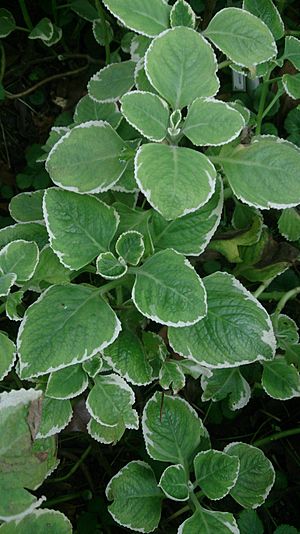Coleus amboinicus facts for kids
Quick facts for kids Coleus amboinicus |
|
|---|---|
 |
|
| Scientific classification | |
| Genus: |
Coleus
|
| Species: |
amboinicus
|
| Synonyms | |
|
|
Coleus amboinicus is a special plant that's part of the mint family. It has thick, fleshy leaves and smells a lot like oregano! People often call it by many names, like Indian borage, Cuban oregano, French thyme, or Mexican mint.
This plant is thought to come from parts of Africa, the Arabian Peninsula, and India. But it's grown all over the world in warm, tropical places. People use it for cooking, as a pretty plant in gardens, and even to make things smell nice. The name amboinicus comes from Ambon Island in Indonesia, where it was first described by a person named João de Loureiro.
Contents
What Does Coleus amboinicus Look Like?
This plant can grow up to about 1 meter (3 feet) tall. Its stem is thick and fleshy. It can be covered with tiny hairs, making it feel a bit fuzzy.
Leaves of the Plant
The leaves are about 5-7 cm (2-3 inches) long and 4-6 cm (1.5-2.5 inches) wide. They are thick and shaped like an egg. The edges of the leaves are a bit bumpy or toothed. They also have lots of tiny hairs, especially on the underside, which can make them look a bit frosted.
The leaves have a very strong smell. It's like a mix of oregano, thyme, and even a bit like turpentine. When you taste the leaves, they are similar to oregano but also have a sharp, minty flavor.
Flowers and Seeds
The flowers of Coleus amboinicus are a pale purplish color. They grow in groups along a tall stem, forming a long, spike-like shape. Each flower is small, about 8-12 mm long.
After the flowers, the plant produces tiny, smooth, pale-brown seeds. They are very small, like tiny flattened circles.
Where Does Coleus amboinicus Grow?
Coleus amboinicus originally comes from Southern and Eastern Africa. You can find it from South Africa all the way up to Kenya and Tanzania. It likes to grow in woodlands, coastal areas, on rocky hills, or in sandy soil.
From Africa, traders like the Arabs helped carry this plant to Arabia, India, and Southeast Asia. This happened along the old trade routes across the Indian Ocean. Later, it traveled to Europe and then to the Americas, which is why it's sometimes called "Spanish thyme."
How People Use Coleus amboinicus
The leaves of this plant have a very strong flavor. People often use them in cooking, especially as a substitute for oregano. It's great for masking strong smells and flavors in dishes like fish, mutton, or goat.
Besides cooking, fresh leaves are sometimes used to make laundry or hair smell nice. It's also a popular plant to grow in gardens because it looks good.
Growing Coleus amboinicus
Coleus amboinicus grows very quickly. You can easily grow it in your garden or in pots indoors. It's simple to start new plants from stem cuttings, but you can also grow it from seeds.
If you live in a dry place, this herb grows best in a spot that drains well and gets some shade. It doesn't like frost, so it grows well in warm, tropical places. If you live somewhere cooler, you can grow it in a pot and bring it inside during winter. In very humid places like Hawaii, it needs lots of sunshine. You can pick its leaves all year long to use fresh, dried, or even frozen.
Other Names for Coleus amboinicus
This plant has many common names around the world:
- Cuban oregano
- Country borage
- French thyme
- Indian borage
- Mexican mint
- Orégano francés (in Spanish-speaking countries)
- Pudina (in Trinidad and Tobago, Guyana, and Suriname)
- Soup mint
- Spanish thyme
- Oregano brujo (witch oregano) in Puerto Rico
- Thick leaf thyme or broad leaf thyme
Images for kids
See also
 In Spanish: Orégano cubano para niños
In Spanish: Orégano cubano para niños







